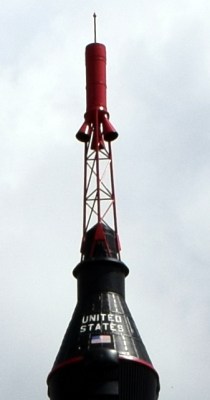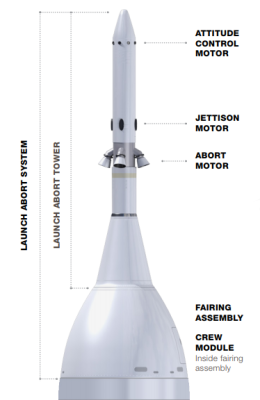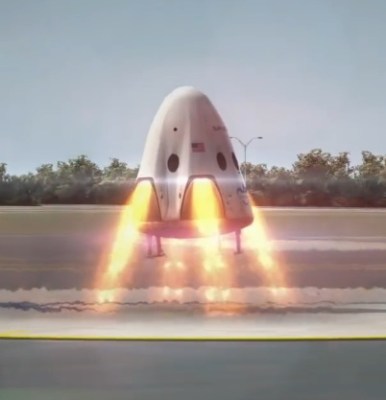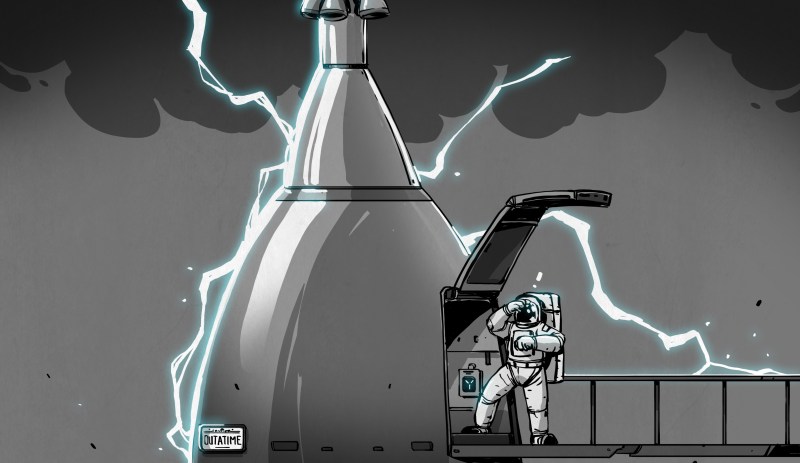Throughout the history of America’s human spaceflight program, there’s been an alternating pattern in regards to abort systems. From Alan Shepard’s first flight in 1961 on, every Mercury capsule was equipped with a Launch Escape System (LES) tower that could pull the spacecraft away from a malfunctioning rocket. But by the first operational flight of the Gemini program in 1965, the LES tower had been deleted in favor of ejection seats. Just three years later, the LES tower returned for the first manned flight of the Apollo program.

With the Space Shuttle, things got more complicated. There was no safe way to separate the Orbiter from the rest of the stack, so when Columbia made its first test flight in 1981, NASA returned again to ejection seats, this time pulled from an SR-71 Blackbird. But once flight tests were complete, the ejector seats were removed; leaving Columbia and all subsequent Orbiters without any form of LES. At the time, NASA believed the Space Shuttle was so reliable that there was no need for an emergency escape system.
It took the loss of Challenger and her crew in 1986 to prove NASA had made a grave error in judgment, but by then, it was too late. Changes were made to the Shuttle in the wake of the accident investigation, but escape during powered flight was still impossible. While a LES would not have saved the crew of Columbia in 2003, another seven lives lost aboard the fundamentally flawed Orbiter played a large part in President George W. Bush’s decision to begin winding down the Shuttle program.
In the post-Shuttle era, NASA has made it clear that maintaining abort capability from liftoff to orbital insertion is a critical requirement. Their own Orion spacecraft has this ability, and they demand the same from commercial partners such as SpaceX and Boeing. But while all three vehicles are absolutely bristling with high-tech wizardry, their abort systems are not far removed from what we were using in the 1960’s.
Let’s take a look at the Launch Escape Systems for America’s next three capsules, and see where historical experience helped guide the design of these state-of-the-art spacecraft.
Orion’s Apollo Heritage
 The similarity to what’s come before is certainly strongest with NASA’s own Orion capsule, which uses a LES tower that at first glance looks like it might be a modified spare leftover from the Apollo missions. In reality, the design has seen considerable improvements since the 1972 conclusion of the Apollo program.
The similarity to what’s come before is certainly strongest with NASA’s own Orion capsule, which uses a LES tower that at first glance looks like it might be a modified spare leftover from the Apollo missions. In reality, the design has seen considerable improvements since the 1972 conclusion of the Apollo program.
Just like the Apollo and Mercury LES towers, the Orion uses a solid-fuel rocket motor in a tractor configuration, which is to say that it pulls the capsule away from the rocket rather than pushing it. Since the rocket motor is in front, angled nozzles are used to divert the exhaust around the capsule itself. As you might expect, there are some cosine losses involved with this off-axis thrust; but considering the Orion LES motor has more total thrust than the Redstone rockets that carried the first Mercury capsules into space, it still has more than enough power to do the job.
Of course, if the LES tower simply accelerated the capsule in a straight line, eventually the rocket would catch back up to it. So not only does it have to pull the Orion capsule forward, it also has to move it sideways to get it out of the path of the oncoming rocket (or potentially, cloud of debris).
The Apollo LES tower actually used a set of canards up at the tip to help leverage the capsule over, but on Orion, it’s all done with vectored thrust. After accelerating along the original direction of travel for several seconds under the power of the abort motor, attitude control thrusters fire and flip the capsule over. This tumble maneuver slows Orion down, at which point the LES tower is jettisoned. The now free-flying Orion capsule would then use its parachutes to land like it would at the end of a nominal flight.
On July 2nd, NASA performed a full-scale test of the Orion LES from Launch Pad 46 at Cape Canaveral Air Force Station. While it didn’t carry a real Orion capsule, or crew, the abort procedure was performed exactly as it would be in an operational mission. The successful deployment of the LES is seen as an important step towards returning astronauts to the Moon.
SpaceX Goes all Out

For Crew Dragon, SpaceX has decided against using the classic LES tower. Rather than putting the abort thrusters out on an arm in front of the capsule, they’ve been built right into the hull of the spacecraft. Instead of solid-fuel, the SuperDraco engines used by the abort system are powered by hypergolic liquid propellants, namely hydrazine and nitrogen tetroxide. Since the two chemicals ignite on contact, the SuperDraco has comparable reliability and response time to the solid rockets used in “classic” abort systems, but with the advantage that they can be throttled down and shut off at will. This means the Crew Dragon doesn’t need seperate thrusters to pitch itself over, it can maneuver using differential thrust between the engines.
Some might argue that it’s an unnecessarily complex approach to the problem, but to be fair, SpaceX had lofty goals for this system when it was designed. Originally, the Crew Dragon was to forgo parachutes and use the SuperDracos to make a powered landing at the end of a nominal mission. This would have made landings far more comfortable for the crew (and sensitive scientific cargo), but NASA decided it was an unnecessary risk compared to splashing down in the ocean so the idea was abandoned. Internal abort thrusters were also seen as a boon for reusability, but since SpaceX doesn’t currently plan on using reused Dragons for crew missions, it seems a moot point.
SpaceX performed a successful test of their LES using a mockup capsule on May 6th, 2015. As with the Orion, this was a “Pad Abort” test, where the LES is engaged while the capsule is stationary. A second test, expected to be conducted before the end of the year, will activate the LES while the vehicle is in flight.
Boeing Plays it Safe
For the CST-100 Starliner, Boeing has taken something of a hybrid approach. They’ve also decided to skip the LES tower, but rather than integrating the abort engines into the capsule itself, they’re part of the service module. This makes reuse impossible since the service module burns up in the atmosphere during reentry, but it does avoid significant integration challenges. In light of the fact that a Crew Dragon was completely obliterated during a SuperDraco test in April, the argument could even be made that it’s a safer approach as well.
The LES on the CST-100 will fire different sets of thrusters depending on when the abort is triggered during the flight. In an early abort, four modified Rocketdyne RS-88 engines will be used to separate the capsule from the rocket. At higher altitudes, the separation can be performed with the craft’s smaller maneuvering thrusters. This is similar to the high-altitude abort profile dramatically demonstrated by the Soyuz MS-10 last year. All of the thrusters utilize the same same hypergolic liquid propellants stored in central tankage; during a nominal flight, orbital maneuvers will be performed with the fuel that would otherwise have been consumed in an abort.
To date Boeing has only performed a static test of the CST-100’s LES, but a Pad Abort test is tentatively scheduled for sometime this summer.
Always at the Ready
While they differ considerably in their execution, the LES for NASA’s Orion, SpaceX’s Crew Dragon, and Boeing’s CST-100 essentially all operate on the same principle of using small rocket engines to get the capsule “up and away” from the rest of the vehicle. Despite the irony of using a rocket to escape another rocket, and more than half a century of technological advancement, it’s still the best way we know of to get the crew away from a potentially deadly situation as quickly as possible.
That said, the most obvious trait that all of these systems share is the fact that every person involved in their design, construction, and testing hopes they will never have to be used in an actual spaceflight. But on the off-chance they ever feel the sharp kick of the Launch Escape System roaring to life, the astronauts aboard these craft can rest assured that an incredible amount of engineering time and effort has been put into giving them the best possible chance of making it home.
















Judging from the Boeing animation, maybe one should buy shares in the parachute company.
But where did they get the power for that flux capacitor? I’m sure in the future, plutonium is in every corner drug store, but in 1955, it was a little hard to come by!
I think you may have missed that episode of “Men in Black”.
B^)
What do the Russians use?
Sled dogs!
It is known as the MES or Mush Escape System.
escape tower for the low stage of the flight…has been used in an emergency and unlike the rest of the rocket, the escape system performed perfectly
Soyuz has a LES tower that looks very similar to the Orion’s. Though when they had their abort in October, it actually happened after the LES tower was jettisoned. So that used a secondary system that was only added in the 1970’s.
Also worth mentioning that the only time (so far) that a LES tower has actually been used in a real-life emergency with humans on board was on the Soyuz in 1983.
That was a pad abort. No LES has been used in flight on a crewed rocket.
no LES *tower* has been used in a crewed rocket in flight
Tractor tower rocket like they did in the 60’s, which is appropriate because it’s on top of a Soyuz like it was in the 60’s.
How many centimeters shorter are you after you got ejected with the crew dragon?
make no mistake, all the escape systems are not a fun ride (or a little too much fun, depends on the person experiencing it…), they have to be able to out-accelerate the main rocket at max. acceleration (read more then 3G at minimum)
The escape system accelerates the capsule away from an already accelerating rocket, so a lot more than 3G in total. Since the seats have a horizontal orientation, you’d just get flat, not shorter.
When the abort system kicked in on the Soyuz in 83, it’s estimated the crew went through 16 – 17G, and that was from sitting still on the pad. NASA says that during the Orion LES test it was “only” around 7G though, which is around what they went through during the October Soyuz high-altitude abort.
Yeah, that looked like a rough ride for sure, as specially that flip around chute deployment.
It only has to be slightly more enjoyable than dying though.
SpaceX released a statement today about the April 20 capsule detonation. Their investigation indicates that N2O4 made it into the helium system and lit a titanium check valve on fire.
Several years ago (actually 1997), I had a project out on The Cape on LS 39B. My QC guy for the project was a retired NASA Payload QC Director who had been there since the very early sixties. During lunch we’d drive around and he’d tell me about the early days. There’s a museum on the Air Force side (closed to the public last I heard – at Pad 14 I think – I’m getting old!) where John Glen first took off. I’d just returned from West Texas and remarked that the launch boom looked like the derrick of an old drilling rig I’d seen in the Oil Drilling Museum in Midland. My friend said that was exactly what it was – that’s what they used for the early Mercury launches.
He said the Mercury Seven astronauts were the heroes of everyone who worked at the pad. The local Chevy dealer would give the astronauts red Corvettes to use when they were in town, and he said you could always tell “Gordie” Cooper’s Corvette from the others as it was either stopped or running wide open. This reminded him of an example.
They had a demonstration for an escape device out at the pad one day (supposedly built by a friend of one of the generals), and the pad was full of scientists, American and ex-German generals, and many of The Seven astronauts. (At the time my friend was a kid just out of college and operated one of the petal-powered optical trackers during launches).
The inventor arrives in a tiny Renault Daluphine. He removes a backpack from the car , puts it on, and climbs onto the roof of the car. He explains that in the event of a problem with the rocket, the astronaut had only to get out of the capsule, step off the gantry and ignite the backpacks rocket motors and it would lower him safely to the ground. As he says this, he steps off the car hits the igniter and, other than breaking both ankles when he hits the ground, nothing happens.
Everyone’s underwhelmed at this waste of time but while the EMT guys are working on the guy’s ankles so they can move him, Gordie’s playing with the backpack. He says’ “I think I see what the problem was”. He tinkers with it a bit and before anyone can react, puts it on, climbs sixty feet up the derrick and steps off. It ignites and lowers him to the ground!
Those guys earned their money…
Cool bit of folk lore, but I’m calling bullshit on it actually happening. A) even back then the Pad would be restricted access.. ok, MAYBE the inventor had access.. sure… but B) rocket exhaust is freaking hot! Gordie’s legs would be cooked/burnt by the ordeal. And C) there’s not enough fuel capacity in a backpack’s volume to make the descent safely.
I don’t know your background but I wouldn’t envy your perspective without a relevant one. As far as I know it was a true story, told by someone who had been there. I can’t say I was told the design details and I doubt my friend had them. However:
I don’t understand the comment about access. I did mention the inventor was the friend of one of the generals (who had obviously, I thought, set up this demonstration) and everyone was obviously waiting for him. Maybe I didn’t state it well or I don’t understand your point.
Your comment about the fuel capacity being inadequate is based on which fuels, what volume, under what load, producing what estimated burn time? We can assume the distance in this case was 60 feet. If someone were to ask my opinion I would have assumed it used hydrazine since a lot of the guys in those years were from Peenemünde and had worked with it (not a likely choice for a backpack these days I assume!). Again I don’t know but I must assume you’ve run the numbers?
The exhaust issue you bring up is true but not at all insurmountable*. Stability is the bigger problem. Look at how BelI got around both and it had to operate a lot longer than a sixty-foot drop. I use the term backpack since that’s the term that was used by my friend. I’ve always wondered why we never heard more about the “backpack” but it could be anything from dangerous propellants to it being super unreliable, to the issue of how much a user would weigh when using it. It obviously only slowed and stabilized the fall – not exactly a Bell rocket belt (although I can’t say it wasn’t related)!
Mark Twain said a good story beats a bad fact but I’ll go with this being a good fact based on my friend’s integrity and history. What would be considered bullshit in Duluth was often just SOP at The Cape, especially in the days before the Apollo fire.
* = I was on a carbon fiber plant years ago (P.A.N. fiber), with furnaces that operated at 3000 Centigrade. I learned quickly that there’s a temp-to-time ratio on how various materials react/get destroyed. You can get away with a lot of heat sometimes for a very short period of time (I feel now I should clarify that’s a general comment on thermal behavior – I’m not referring to Gorgie’s legs lest I precipitate another misunderstanding!).
The Shuttle could have had an emergency crew cabin separation system. The two deck pressurized crew compartment was mounted at only (IIRC) six points to the rest of the vehicle. With some explosive cord embedded in the right places, like many British fighter jets have in their canopies, and explosives to shear the mounting points, a Shuttle crew compartment could have been cut free from the vehicle, with a rocket to fling it out and away from the rest of the stack.
The way Challenger came apart, the crew cabin remained at least structurally intact until impact in the ocean. An escape system could have sheared away the cabin from whatever other parts were hanging on, then parachutes deployed. It would have been a *possibility* of survival instead of the absolutely zero chance they had.
What was added to the Shuttles after Challenger was based on the presumption of an event like an engine failure at a point where Trans-Atlantic Abort or Return To Launch Site, or a once around Earth at very low altitude wasn’t possible. The Shuttle would have to remain intact, separated from the SRBs and ET, in a stable glide so the crew could use the curved rail to fling them away from the Shuttle as they bailed out one at a time. In other words, completely useless in any kind of catastrophic failure.
the Shuttle WAS to have a system for emergency egress of crew… then the Air Force decided they wanted the Shuttle to do a bunch of other crap (that they never used it for) and the Egress system was scrapped.
“In light of the fact that a Crew Dragon was completely obliterated during a SuperDraco test in April, the argument could even be made that it’s a safer approach as well.”
It wouldn’t be a very good argument. Boeing lost their first pad-abort test capsule to a fire cause by a valve design failure in the abort system plumbing after a hot-fire test before their first attempt at a pad abort test.
There was no capsule to lose, they have only tested the service module.
More to the point, a fire in the service module isn’t of much concern since the capsule separates from it anyway. But the Crew Dragon anomaly would have been a death sentence for anyone aboard.
Combined with the TVT fail, Boeing are also down one entire vehicle. The CFT service module was taken for the pad abort to replace the destroyed one, and the CFT capsule was taken for OFT (because the OFT capsule failed thermal vacuum testing). Being will need to construct a whole new vehicle for CFT.
The Apollo LES had a pitch motor up at the top of the stack to get the spacecraft out of the path of the booster. The canards were used to re-orient the stack blunt end forward.